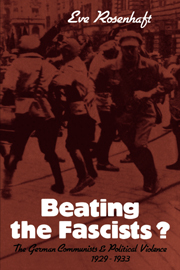Book contents
- Frontmatter
- Contents
- Preface
- List of abbreviations
- Map 1 Greater Berlin 1930
- Map 2 Central Berlin 1930
- 1 Introduction: Social crisis, radical politics and organized violence in Weimar Germany
- 2 The Party, the neighbourhood and the uses of violence in the ‘Third Period’
- 3 Defining the enemy: The wehrhafter Kampf against the SA in theory and propaganda
- 4 Organizing the wehrhafter Kampf: The Communist defence formations
- 5 Between ‘individual terror’ and ‘mass terror’: The campaign against the SA-taverns, 1931
- 6 The shape of violence in the neighbourhoods
- 7 Who were the streetfighters?
- 8 Conclusion: Communist politics in the Weimar Republic
- A note on sources
- Notes
- Bibliography
- Index
8 - Conclusion: Communist politics in the Weimar Republic
Published online by Cambridge University Press: 05 March 2012
- Frontmatter
- Contents
- Preface
- List of abbreviations
- Map 1 Greater Berlin 1930
- Map 2 Central Berlin 1930
- 1 Introduction: Social crisis, radical politics and organized violence in Weimar Germany
- 2 The Party, the neighbourhood and the uses of violence in the ‘Third Period’
- 3 Defining the enemy: The wehrhafter Kampf against the SA in theory and propaganda
- 4 Organizing the wehrhafter Kampf: The Communist defence formations
- 5 Between ‘individual terror’ and ‘mass terror’: The campaign against the SA-taverns, 1931
- 6 The shape of violence in the neighbourhoods
- 7 Who were the streetfighters?
- 8 Conclusion: Communist politics in the Weimar Republic
- A note on sources
- Notes
- Bibliography
- Index
Summary
The streetfighting of the Depression years was one consequence of a shift in the bases of working class and popular politics. The changes were both material and organizational; new kinds of political movements appeared as the economic and social structures through which the old ones had operated broke down. The migration of working-class radicalism from the workplace to the neighbourhood was a function equally of the effects of employment patterns and the beginnings of the welfare state on the way collective interests were structured and perceived and of the specific politics of the radical working-class party, the KPD. The terror of the SA, as one of a whole range of grievances peculiar to the neighbourhood and a threat specifically directed against working-class radicalism, evoked a response with the weapons familiar to the neighbourhood. There the active use of physical force, by bailiffs, policemen, ‘criminals’ and ordinary people was a form in which power was commonly exercised; and violence gained in importance as the Depression diminished the workers' capacity to participate in the cash nexus.
This helps to explain why the neighbourhoods became an object of the political fight and why, once the NSDAP had raised its challenge, the fight became an increasingly bloody one. It does not explain why the KPD found it impossible to transform ‘individual terror’ into ‘mass terror’, except insofar as the use of economic force through boycotts, rent-strikes and protest strikes was intrinsic to the conception of ‘mass terror’.
- Type
- Chapter
- Information
- Beating the Fascists?The German Communists and Political Violence 1929–1933, pp. 208 - 215Publisher: Cambridge University PressPrint publication year: 1983



